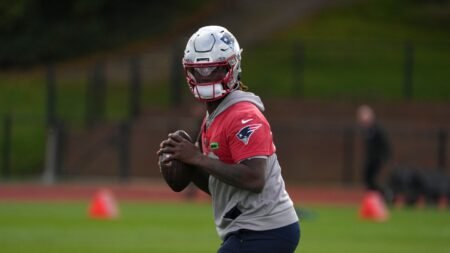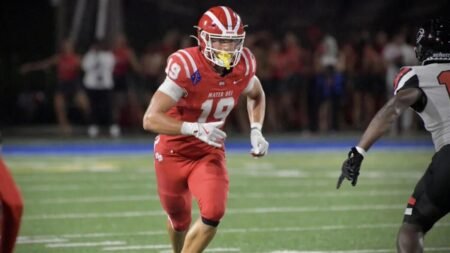All data via TruMedia unless otherwise stated.
“Copycat league” is the common refrain when a trend starts appearing enough in the NFL to invoke the Baader–Meinhof phenomenon, whether it be a coaching hire, a personnel preference, a scheme quirk. These things catch on quickly in the ever-evolving and ever-changing world of NFL teams that are constantly studying themselves, their rivals, and their collegiate and high school peers.
Advertisement
What takes the league by storm in September will be imitated, dominated, and even improved upon by the time the holiday season rolls around (ask the recent Dolphins offenses).
Sometimes there are schemes that have fallen out of favor that have been dusted off, redesigned or distilled and found new ways — or sometimes just the classic ways — to be used. Even as just a change-up to whatever has become the norm.
Straight dropback passing is making a comeback
One type of play that I think will start gaining more favor, even if it’s just a slightly bigger blip on the radar, is a tried-and-true play that you could say John Heisman and Teddy Roosevelt helped invent. That’s the straight dropback pass from under center.
Advertisement
Throwing the ball without any play action (a play fake to the running back) is one of the main food groups of football concepts. But what was once the staple of this diet, throwing the ball from under center, has instead been substituted with a lean into the pass-centric nature of modern offenses. There’s been more shotgun or even pistol as the base set of offenses, which helps create space and read elements in the run game for more athletic quarterbacks and allows them to see more of the field. Under center plays have morphed into a clear signal of either a run play to a back, or play action off faking it. It’s removed scissors in the constant game of rock, paper, scissor that offenses and defenses throw at each other.
Basing out of shotgun absolutely has benefits in attacking a defense, including certain RPOs and in quick game, along with varying motion quirks you can throw in. But I think the NFL hit its nadir in using straight dropback passing, which was once a Day 1 installation for offensive football.
Advertisement
NFL offenses threw the ball from under center on early downs 11,367 times in 2002, over 22 times a game. In 2024 that number was 2,855, or 5.3 times per game. And that’s including play action. Without play action, that number dropped to 1.1 in 2023 before having a slight increase this past season. I think we’ll see an upswing in usage as teams see the benefits of giving defenses another thing to think about. All while hunting explosive plays on early downs and having some old-school soundness in protection and play design. (The classics are the classics for a reason. Even if they aren’t cool at the moment.)
The offensive play-callers that are the main practitioners of this ancient art of passing are actually the coaches that were recently labeled as the wunderkinds of the league. The 49ers under Kyle Shanahan led the way with 2.6 under center dropbacks without play action on early downs per game in 2024, averaging over nine yards per play. The Saints under Klint Kubiak (of the same Shanahan-Kubiak coaching tree) were in second. Kubiak’s 2021 offense, meanwhile, ran more than five per game, and his father Gary’s offenses in Minnesota topped the leaderboard since 2019. Other offenses from the same tree rounded out the top five of straight dropback passing in 2024, including the Texans, Vikings and Lions.
Brock Purdy and the 49ers led the NFL in under center dropbacks with no play action on early downs in 2024. (Photo by Thearon W. Henderson/Getty Images)
(Thearon W. Henderson via Getty Images)
There are numbers past the eye test that indicate that these plays are more than just a football version of an eephus pitch. I think NFL teams will add it to their arsenal in the coming years. On dropback passes featuring no play action since 2019, under center concepts have a higher success rate (49.3%), net yards per attempt (6.6), and EPA per play (.05) than their shotgun (45.4%, 6.3, 45.4%) and pistol (46.1%, 6.5, .02) compatriots.
Advertisement
There are tradeoffs for operating under center, most notably with inside pressure and the lack of space (relatively) to the line of scrimmage for the quarterback (which is dangerous against modern interior defensive lineman). But as defenses have become more complex and have better access to opponent scouting and tendency data than ever, offenses have to find ways to keep them on their toes. Indicating clear run or clear pass just by where the quarterback is aligned already puts the offense behind the 8-ball. Sprinkling in a few more old dropbacks will help keep the cue stick in the offense’s hands.
Third and fourth downs are a whole new ballgame now thanks in part to shorter fields
Rule changes can have other effects on the game outside of just the plays they are intended to impact. The NFL’s kickoff rule changes, which first moved the ball up to the 25 after touchbacks in 2018 and then turned into the new “dynamic kickoff” implemented last season, had ramifications on other aspects of the sport as well.
NFL offenses averaged 62.2 plays per game in 2024. That was the lowest league-wide mark since 2008 and the second-lowest since 2002, when the NFL expanded to 32 teams and eight divisions. NFL offenses also averaged 10.7 drives per game in 2024, the lowest league-wide number over the same time period.

(Via TruMedia)
Why? Well, the ball being spotted further down the field after touchbacks (which will bump even further this season to the 35-yard line following another rule change) means, just by sheer math, less yards offenses have to gain to score on a given drive. NFL teams are also going for it on fourth down more than ever, and plays per drive has gone up as well.
Advertisement
The NFL is so situational and now that the math has changed, offenses are also adjusting how they go about situations like third and fourth down. Teams are not only going for it more on fourth down, they’re getting better at it, too. NFL offenses converted 56.4% of their fourth down attempts last season, the highest league-wide conversion rate since at least 2002. They are treating third down differently, too. Particularly third-and-long situations, commonly defined as third down and seven or more yards to go. Three of the four worst league-wide conversion rates on third-and-long have happened since 2022, the same time that fourth down aggression has become more normalized. Offenses are realizing that third down no longer requires an all-or-nothing play call with a long-developing dropback pass or a shrug of the shoulder white flag screen or draw play that has a fanbase calling for their offensive coordinator’s job.
Instead, fourth down aggression has opened the playbook for offenses on third down. Screens are now an easy button that can put you in strike range on fourth down. Checkdowns are no longer groan-worthy, but instead a viable option that can put the offense in a better position for the next down. NFL offenses are even running the ball more frequently on third-and-long now to catch exotic, blitz-happy defenses by surprise and out of position; 10.7% of third-and-longs in 2024 featured a designed run play, the highest league-wide rate the NFL has seen since 2009, when two-high coverages and the Ravens/Rex Ryan’s blitz-happy ways were in vogue.
It’s not a coincidence that the numbers are more similar to the late 2000s than something five years ago. It was a similar environment back then to what current NFL offenses have to deal with, after a decade of single-high defenses trying to emulate the Legion of Boom. Albeit current offenses have to deal with even more aggressive and dynamic looks and an onslaught of pass rushers on a weekly basis.
Advertisement
NFL defenses are getting even better and better at disguising and providing window dressing on their defensive looks. And this is on top of the depth of pass rushers that every team is seemingly armed with these days. But NFL offenses have started to figure out some things on late downs. While their third-and-long rates have dropped, they have actually racked up strong overall third down conversion rates (fourth-highest since 2002), and NFL offenses recorded a 52.6% conversion rate on third-and-six or less in 2024, which was a top-five conversion rate since 2002. It’s a nice indication of the current upswing in play-calling and quarterback play league-wide. (Yes, really, don’t let anyone scream at you differently.)
Road grating run games taking advantage of lighter defenders
Ball carriers are also gaining more yards after contact than ever before, too. Running backs gained an average of 3.02 yards after contact per designed run attempt in 2024. That’s the highest since 2006 (the furthest TruMedia’s data goes back for this statistic) and the first time that number has ever cracked three yards. While yards before contact still remain relatively low (1.35 yards, fourth-lowest since 2006), which I think is a fair reflection of the talent disparity between NFL offensive lines and defensive fronts, I also think this reflects the tradeoff of size for speed that NFL defenses have undergone over the last five to 10 years.
In 2024, the average playing weight among NFL defensive linemen and linebackers that played 200 or more snaps was 271.2 pounds. In 2018, that number was 272.5 pounds. In 2013, it was 276.5 pounds. NFL front seven defenders have become lighter and faster, a reaction to a more pass-heavy NFL that requires better pass rushers and coverage defenders to throw at these talented quarterbacks, pass catchers, and passing games. Defenses are going lighter as defenders’ position labels start to merge. A player listed as a safety could line up in the box like a linebacker or in the slot more frequently than they do as a deep coverage player. Sub-230-pound linebackers are becoming more the norm than a curiosity. Edge defenders are asked to align inside on passing downs to attack mismatches against guards (who are becoming more skilled in their own right).
But this has opened up avenues for offenses to attack. Namely, just being big up front and road grating jittery defenses with downhill gap runs. Offenses leaning into their more athletic quarterbacks and their running ability has also changed the math of how defenses have to attack, with more plays featuring a read element out of the shotgun changing the angles and forcing defenses to rally and tackle in space and swarm with numbers. NFL offenses have benefitted when defenses don’t have good eyes on these plays; the NFL’s 8.3% explosive run rate on early downs was the second-highest league-wide number since 2002.
Tight ends creating mismatches that trickle down throughout offenses
Another way offenses are creating more advantages is by using the classic mismatch staple: tight ends. Just as defensive body types start to merge, pass catchers, blockers and ball carriers are starting to blend as well. Big-bodied wide receivers who can’t consistently win on the outside are moving inside as power slots, becoming de facto tight ends inserting as blockers at the point of attack on run plays. (Or as runners — the five highest rates of WR runs league-wide since 2002 have been over the last five seasons.)
Advertisement
Receiving ability is a prerequisite to be a modern NFL running back. Quarterbacks run more than ever, with scramble rates rising every year (and not slowing down with the likes of Jayden Daniels, Drake Maye, and Bo Nix establishing themselves). Athletic tight ends that used to get squeezed off the field because of their lack of blocking ability are starting to find a role again. NFL offensive play-callers are no longer asking receiving-first tight ends to down block an oversized defensive end. They’re putting players in motion to build momentum and alter angles of blocks on the defense right at the snap of the ball. RPOs allow tight ends to not even have to block, but instead run a simple route instead.
Play-callers are aligning them all over the field. Offenses are moving these guys around and creating two-back and full house backfields with tight ends (and even receivers). It changes up the strength of the run and the gaps the defenders have to account for after the snap of the football. And it gives defenses even more to prepare for out of certain personnel groups. The Ravens have weaponized these looks to open up their run game menu with Lamar Jackson. But other teams are starting to use more formational variety with their skill players on other type of concepts as well. Particularly teams like the Bengals, Packers, Cardinals and Falcons.

The Rams appear to be planning on “replacing” Cooper Kupp, who performed many tight end roles in their offense, with rookie Terrance Ferguson (pictured) and the rest of their tight end room. (Photo by David Crane/MediaNews Group/Los Angeles Daily News via Getty Images)
(MediaNews Group/Los Angeles Daily News via Getty Images via Getty Images)
And while defenses are now more comfortable using nickel (five defensive backs) and even dime (six defensive backs) to counter multi-tight end looks and hold up against the run, offenses are also starting to find ways to use their natural size advantage. Since there are more safeties in the box and linebackers are no longer 260-pound rhinos steamrolling blockers, tight ends can now be asked to insert and lead block on the second level. That opens up the menu to feature even more two-back-type runs (think fullback-type plays), but from a more spread look. This is on top of the other plays that feature motion at the snap.
Advertisement
Narratives about how tight ends create mismatches or how there’s a new tight end wave are old hat. But there was an increase of multi-tight end personnel groupings in 2024 that matches the eye test: NFL offenses used 12 personnel (1 RB, 2 TE, 2 WR) at the highest rate since 2013, which is the furthest that TruMedia’s data goes back. Offenses used two or more tight ends on 7.6% of plays in 2024, the highest rate since at least 2002.
Viable tight ends are always going to be hard to find because of the sheer athletic threshold for playing the position. But the ease of entry as a blocker has lowered, along with the increased athleticism and skills of a younger generation, has opened up roles for these players.
There are teams, like the Rams and really the entire NFC West, that are tipping back their personnel usage to featuring more size with tight ends than the three-wide receiver meta of recent years. The Rams are seemingly “replacing” Cooper Kupp, who often performed many tight end-esque roles in that offense, with their tight end room of Tyler Higbee, Terrance Ferguson, Colby Parkinson, and Davis Allen.
With more talented tight ends entering the NFL in the recent draft, it’ll be fun to see more and more teams inverting the role of their skill players.
Read the full article here














